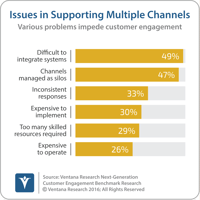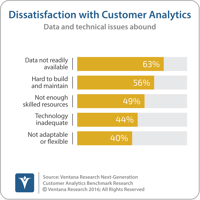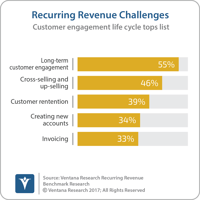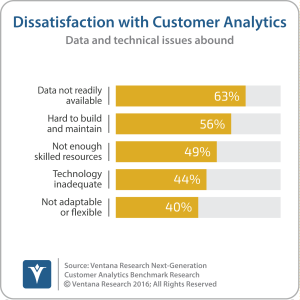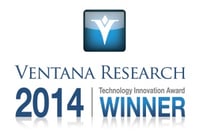Ventana Research recently announced its 2023 Market Agenda for Human Capital Management, continuing the guidance we’ve offered for two decades to help organizations derive maximum potential from workforce- and people-related technology investments and initiatives. In crafting this Market Agenda, we focused on three critical themes top-of-mind for both HCM vendors and buyers: Organizational resiliency, employee engagement and utilizing digital technology to derive deeper insights into the state...
Read More
Topics:
Human Capital Management,
Employee Engagement,
Learning Management,
Talent Management,
Workforce Management,
Payroll Management,
Total Compensation Management,
employee experience
The HCM software market continues to evolve at an unprecedented pace. The innovations we’re seeing are exciting new features and capabilities, but many have more profound impacts: They provide organizations with more effective ways to serve their customers and enhance their experience. HR’s customers –employees, managers, retirees, candidates, leadership and external partners – can now access and take advantage of native mobile apps, virtual agents and chatbots (via text or voice) as well as...
Read More
Topics:
Human Capital Management,
Employee Engagement,
Employee Productivity,
HR technology,
HCM Systems
Over the last few years the telecommunications and call center industries have undergone radical changes. Telecommunications was mainly in the hands of national and regional telecom companies, which essentially owned all the cables in the ground. The call center market was dominated by a small number of vendors that provided on-premises systems to manage and route calls when they arrived at a company’s offices. The telecom model was in effect the first cloud-based service, though almost no one...
Read More
Topics:
Customer Analytics,
Customer Engagement,
Customer Experience,
Speech Analytics,
Employee Engagement,
Analytics,
Cloud Computing,
Customer Service,
Call Center,
Contact Center,
Contact Center Analytics,
CRM,
Text Analytics
Our benchmark research into the next-generation contact center in the cloud confirms what most people intuitively know – that consumers now engage with each other and organizations through more communication channels than a few years ago and that many of these are speech- and text-based. Companies are therefore generating large volumes of voice recordings and textual records. They contain vital information about what customers feel about issues connected to their dealings with the organization...
Read More
Topics:
Customer Analytics,
Customer Engagement,
Customer Experience,
Speech Analytics,
Employee Engagement,
Analytics,
Cloud Computing,
Customer Service,
Call Center,
Contact Center,
Contact Center Analytics,
CRM,
Text Analytics
Zuora provides software that supports the rapidly expanding subscription economy. I recently attended the company’s user event in London, called subscribe16. During his keynote speech CEO Tien Tzuo insisted that the subscription economy is not only here to stay but is likely to grow substantially. In the U.K. alone, he said, 40 million users are using subscription services, including 14 million use video streaming services, 5.4 million use music streaming services, and perhaps most surprising,...
Read More
Topics:
Customer Analytics,
Customer Engagement,
Customer Experience,
Speech Analytics,
Employee Engagement,
Analytics,
Cloud Computing,
Customer Service,
Call Center,
Contact Center,
Contact Center Analytics,
CRM,
Text Analytics
Robotics is nothing new to some aspects of manufacturing and the IT industry, but it is relatively new in the customer experience (CX) market. The term often conjures up images of little gray machines taking over tasks previously handled by humans – machines making cars, programmed vacuum cleaners and the like. In the CX space, however, we are not talking about machines but about software that can automate routine tasks. For the time being, I don’t believe robots will take over the contact...
Read More
Topics:
Customer Analytics,
Customer Engagement,
Customer Experience,
Speech Analytics,
Employee Engagement,
Analytics,
Cloud Computing,
Customer Service,
Call Center,
Contact Center,
Contact Center Analytics,
CRM,
Text Analytics
Analysts have been talking and writing about a “360 degree” view of the customer for years. Our own benchmark research into customer relationship management shows that only37 percent of organizations are able to produce analysis and reports that yield such a comprehensive view. Other research into next-generation customer analytics reveals that the main issue in this area for nearly two-thirds (63%) of organizations is data availability. To make the situation worse, customer-related data is...
Read More
Topics:
Customer Analytics,
Customer Engagement,
Customer Experience,
Employee Engagement,
Analytics,
Cloud Computing,
Customer Service,
Call Center,
Contact Center,
Contact Center Analytics,
CRM,
Text Analytics
This year Oracle OpenWorld conference opened with a fiery speech by Larry Ellison, who has stepped down from his role as CEO to become Executive Chairman and CTO. Filling his rhetoric with claims of market leadership and attacks on competitors SAP and Workday, Ellison set an aggressive tone for those who followed him. In a talk relevant to my research practice, Chris Leone, senior vice president of applications development, asserted that Oracle is making progress in human capital management...
Read More
Topics:
Mobile,
Social Media,
HCM,
Human Capital Analytics,
Human Capital Management,
Core HR,
Employee Engagement,
Platform as a service,
TM,
Wellness,
Analytics,
Business Collaboration,
Cloud Computing,
Collaboration,
Mobility,
Oracle,
HRMS,
Talent Management,
Social,
PaaS
Cornerstone OnDemand is a large pure-play vendor of talent management software, with more than 1,700 clients, more than 14.5 million users and more than 60 percent growth in revenue over the past 12 months. At the company’s annual customer conference this year, CEO Adam Miller talked about a trend in the market of talent management applications going beyond automating a series of processes to help engage employees within organizations. I agree with this analysis and would extend the trend to...
Read More
Topics:
Social Media,
Human Capital Analytics,
Human Capital Management,
LMS,
Employee Engagement,
Employee Onboarding,
Usability,
Analytics,
Business Analytics,
Business Collaboration,
Cloud Computing,
Workforce Performance,
Cornerstone OnDemand



